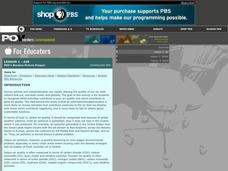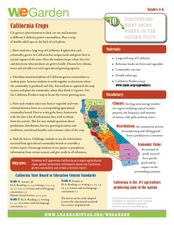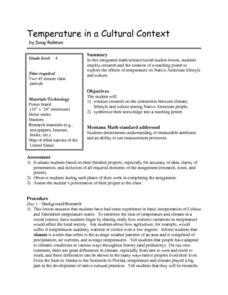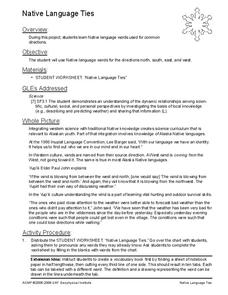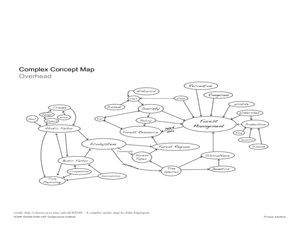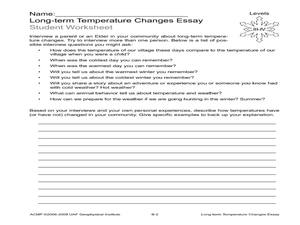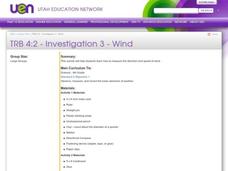Curated OER
Acid Rain
Students identify the causes and effects of acid rain. Using the internet, they research pollution sources in their local area and by collecting rain samples and testing the pH. In groups, they develop their own plan urging local...
Curated OER
Air Masses
Students examine the physical characteristics of several types of air masses to discover how air masses can be identified and defined by their temperature and moisture content.
Curated OER
Take a Deep Breath: Air Today, Air Tomorrow
This is the introductory instructional activity in a series about air quality. Why is it so important that we breathe clean air? How can we make sure we're keeping our air clean? A discussion is the central idea of the instructional...
Curated OER
P.O.V.'s Borders Picture Project: Lesson 1 - Air
Take photos of human activities that impact air quality. Collaborative groups present one of the photographs, identifying how the activity contributes to air quality and what can be done to minimize the impact. As one in a series of...
Curated OER
The Fabled Maine Winter
Students graph and analyze scientific data. In this research lesson students use the Internet to obtain data then draw conclusions about what they found.
NOAA
El Niño
El Nino, La Nina ... and the Santa Maria? The 11th installment of a 23-part NOAA Enrichment in Marine sciences and Oceanography (NEMO) program explains the mechanism of El Nino/Southern Oscillation. Pupils use previous data to determine...
Curated OER
2nd Grade - Act. 27: How Animals Prepare for Winter
What do animals do during the winter? Second graders will discover that some animals migrate and other hibernate during the winter. Using "How and Why Animals Prepare for Winter," by Elaine Pascoe, they will discuss and create a drawing...
Curated OER
Clouds: an Internet Based Lesson Plan
Students watch a teacher demonstration of cloud formation. They research cloud formation on the Internet to write reports that summarize the process of cloud formation.
Curated OER
Is It Breathable?
Young scholars explore air quality. In this environmental lesson, students observe a simulation of air pollution by blowing into a jar (with a straw) that has chalk dust. Young scholars discuss how air quality can effect the way we breathe.
Curated OER
VOLC TV News Team
Students produce a 5 minute internet news cast about an active volcano
Curated OER
Air: Air Quality Picture Project
Learners recognize which activities contribute to poor air quality and which contribute to good air quality. They discover how air quality is measured, and come up with ways that humans can have a positive affect on air quality.
Curated OER
California Crops
Students explore agriculture by researching the native food crops of California. Students define a list of agriculture vocabulary terms and analyze maps of California which explain which foods come from which area. Students write a...
Curated OER
Temperature in a Cultural Context
Fourth graders investigate the effects of temperature on Native American lifestyle and culture. In small groups they conduct research on cultural practices showing a connection to the climate and create a poster displaying their...
Curated OER
Native Language Ties
Students complete a worksheet on Native Language. In this language and culture lesson, students learn Native language words for the directions north, south, east and west. Students complete a worksheet to show what they have...
Curated OER
What Are We Looking At?
Students investigate different perspectives through a farming simulation. In this photo perspectives lesson plan, students examine different photographs taken by satellite or from ground level. Students then discuss the differences and...
Curated OER
Project Jukebox
Students analyze an interview with the Climate Change Project Jukebox in order to help them undertand how to use a concept map. In this writing and climate change lesson, pairs of students log onto the Internet site for Climate...
Curated OER
The Staycation
In this current events worksheet, students read a 5-paragraph article about "staycations" and respond to 6 short answer questions. Vocabulary words and definitions are included.
Curated OER
Long Term Temperature Changes Essay
Young scholars interview Elders in their community about how temperature changes have affected their lives. In this temperature change lesson plan, students interview the Elders about the societal and environmental changes that have...
Curated OER
Wind
Fourth graders are read a story and answer the comprehension questions about sound and wind. In groups, they make their own wind vane and how to determine the direction of the wind. To end the lesson, they make their own Anemometer to...
Curated OER
Breaking News English: Hurricane Dennis Menaces U.S. Coast
In this English worksheet, students read "Hurricane Dennis Menaces U.S. Coast," and then respond to 1 essay, 47 fill in the blank, 7 short answer, 20 matching, and 8 true or false questions about the selection.
Curated OER
Algebra, Multiplication, and Division of Fractions
Students gain knowledge by measuring time and distance for solving unknowns in an equation. They also will design an airplane and chance to communicate mathematically by writing essays.
American Museum of Natural History
American Museum of Natural History: Make Your Own Weather Station
Students can plan and carry out investigations of local weather patterns by building their own weather stations to collect observations of various weather conditions: rainfall, wind direction, and air pressure.
PBS
Pbs Learning Media: Weather: Collection: Bringing the Universe to America's Classrooms
Get up close to a variety of weather conditions, encounter local weather patterns through spectacular imagery, and learn how to observe and describe different weather conditions with the beloved characters from PEEP and the Big Wide...
Other
Siemens Science Day: Earth Science: How's the Weather? [Pdf]
Students make their own weather station by using homemade version of real weather measurement equipment and use their equipment to make observations and predictions about the local weather.



